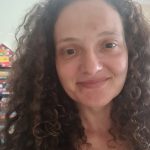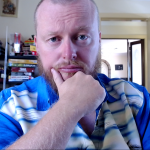
Dr Valentina-Mira Wheeler
University of Wollongong

Dr Glen Wheeler
University of Wollongong
We talk to Dr Valentina-Mira Wheeler and Glen Wheeler about the work they do, how important mathematics is to everyday life, and their secret talents.
1. How do you explain your work and its real-world impact to people outside of the mathematical sciences?
Valentina: Any real life phenomena has an underlying mathematical equation. Finding this equation and studying it gives you information about the phenomena. The flows are describing changing or morphing objects. Mathematically we can translate the flow into a differential equations that one can study based on its initial conditions to give information about how the object being changed by the flow will look at a later time.
For example a fire line can simplified to a geometric line in a plane that we move for each time based on conditions at that time. This can be fuel or wind or terrain. The movement can be described by a second order differential equation. If we solve or approximate its solution we can say where the fire line will move in 10 minutes, in 10 hours or so on.
Glen: I like to explain the deeper role that mathematics plays in everyday life. I often think back to conversations around our son’s school, where teachers have said “I understand that mathematics is important when adding up money, or working out how much fuel will cost, but what is all that other math used for?” I try to unpack the myriad of ways in which mathematics has enabled the advancement of human civilisation in ways that are essentially invisible to 99% of the population.
I then like to try and impress upon my probably-infuriated audience (who can’t wait to escape, or at least find another beer) why it is important that mathematics be studied as a discipline in and of itself. It really is the best way. We really need to move on from the current fetish where mathematics always needs an immediate application to have value.
2. What drives your interest in this field?
Valentina: The desire to know more and answer the questions that keep appearing in maths. How would this move? Why would this move? Where can I use it?
Glen: I have convinced myself that discovering new knowledge and then teaching that to other people is of great intrinsic value. I love doing that. I am driven by passion for what I do.
3. What do you consider your biggest achievement to date?
Valentina: Probably my work on free boundary mean curvature flow but I do feel very dearly about the fourth order flows applications to red blood cells modelling.
Glen: I am really happy with my work on education, in particular on the mathematics curriculum at UOW. Every semester when I get feedback from students, I have a great feeling of achievement. Or, relief, that my students did get something after all of worth out of me for that semester.
In terms of research, I’m just broadly satisfied with my work so far. I’m not even close to done. None of my projects are finished. But with about fifty research articles written so far (well, 44 at last count, but that’s close to 50… right?) I’ve certainly found a lot of things that are worth telling people about.
4. What are the next interesting “big questions” or challenges you hope to tackle?
Valentina: That are the partition problems that I am looking at in my DECRA and their applications to merging moving fronts. A partition problem is a way to split a given space based on rules such as equal areas or volumes. As example one famous problem that is solved is the question on why are the bees constructing their honeycomb with hexagonal cells? Because that uses the least wax (so least area) to have enclosed the maximum amount of honey so maximum volume.
Glen: I want to better understand singularity formation for the three major fourth-order curvature flow: Chen’s flow, the Willmore flow, and surface diffusion flow. That’s been a big challenge of mine since my Humboldt fellowship during my time in Germany. Everyone is interested in it, and nobody can do it. We are all circling around it, publishing little pieces here and there, but no big breakthrough yet. I want to be the person who makes the breakthrough.
5. If not mathematics research, what would have been?
Valentina: Probably I would have followed a medical career. I was quite interested in cardiology for a while. But maths won.
Glen: Well, I was working in computer security. I ran a computer business. But I really hated it. I find quiet enjoyment in painting and writing, and I do love video games, so maybe working for a game studio? I’m not great at being told what to do, so maybe I’d have an indie game studio myself. Making just enough money to live off two minute noodles, but happy.
6. What is the best piece of advice you’ve received?
Valentina: Never give up. I think it goes for everything. If you want something just go for it. No matter how crazy or out of reach it is.
Glen:
“I have no idea how to do this!! ☹” (Glen is clearly distressed)
“Just do it.” (Klaus told me to just do it)
“But I told you. I can’t. I have no idea what you’re even talking about.” (Glen is about to cry)
“Alright. Here’s the secret. It’s a two step process. Step one: sit down. Step two: do it.” (Klaus tells Glen as if it is the road to el Dorado)
You’d be surprised how often you really can do something, you just need to convince yourself that it is possible.
7. If you could have any superpower, what would it be?
Valentina: Speed! Not enough hours in the day. A bit of Flash power would be good.
Glen: Hmmm. I’d like to have the superpower to make everyone never get sick, or old, solve all problems of overpopulation, climate troubles, and make the universe a utopia. Oh, and everyone should watch my youtube videos. That would be nice.
8. Rock star scientist, master chef, closet artist, what is something about you that might surprise people?
Valentina: I have been a RFS firefighter for close to 4 years now. I am both qualified as a bushfire fighter and a Village firefighter with Compressed Air Breathing Apparatus training completed.
Glen: I’m an old man who paints tiny plastic people for fun.
9. Deepening field knowledge and providing a networking platform, why are opportunities such as AMSI Summer School so valuable? What do you hope attendees take from your lectures?
Valentina: Both of those are very good reasons for attending an AMSI Summer school. What I want the students to have at the end of the lectures is a clear idea of what mean curvature flow is and what techniques would one use to study it. But also an understanding of the value of such techniques for other partial differential equations thus other flows that they might discover. That is mathematically speaking.
Also most of the students attending will go to follow paths in academia or industry and it is important that at this stage you get exposed to as many types of mathematics and results as possible before you find your own path.
In terms of networking and AMSI summer school is priceless in starting to create your future academic and professional network.
Glen: A love for mathematics would be nice.
10. If you could be anywhere right now, where would you be?
Valentina: I miss my birth country’s mountains so if I could be somewhere as I write this probably anywhere in Fagaraseanu Carpati would do.
Glen: I’d be on a bike ride with my family. Actually, they left twenty minutes ago, I think I’ll be able to catch them if I leave now! TO THE BIKE!
Dr Valentina-Mira Wheeler and Dr Glen Wheeler will be presenting Mean Curvature Flow – Introduction and Results in Various Settings at the 2022 Summer School hosted by University of Technology Sydney in January.
More about Dr Valentina-Mira Wheeler
I am a geometric analyst specialising in elliptic and parabolic partial differential equations. I possess additional extensive training in differential geometry, calculus of variations, dynamical systems, general relativity and functional analysis. Several of my projects have direct applications to bush fire modelling and biological membrane modelling.
I was born in Romania and after completing a Bachelor in Mathematics and Computer Science I became interested in Differential and Riemannian geometry in General Relativity. My interest was captured by the work of Hamilton and Perelman in solving the Poincaré conjecture. They have used a flow of metrics, an intrinsic flow called Ricci flow, to show that any 3 dimensional manifold can be internally morphed to become a sphere. This led me to an Erasmus sponsored Master thesis at the Freie Universität Berlin with Klaus Ecker. I became a member of the Geometric Analysis group in Berlin/Postdam. Mathematical life there was amazingly rich in seminars and conferences allowing me to build a background and knowledge in partial differential equations and geometric analysis. I became interested in the main object of study of the group, that is curvature flows. A curvature flow is a way to change geometric objects using their differential properties, one being the curvature. I started a PhD with Berlin Mathematical School on the topic of Free Boundary Mean Curvature Flow. Mean curvature flow is the first extrinsic flow that I considered and it still has a special place in my heart. After completion I took a position at Postdam University, touching on fourth-order curvature flows, and expanding into different techniques used in their study.
In 2012 I moved to Wollongong. I have been here since then continuing my research, learning about Australian universities and getting involved in many teaching, research and related activities in the academic community. One of them is promoting equality and equity in the mathematical sciences. I joined WIMSIG (Women in Mathematics Interest Group) and have been part of their Executive Committee for the last 4 years, working toward an inclusive and positive academic environment, something that is very important to me.
Mathematically at this time I started also looking at applications of the flows that I have been studying. Some of the flows I look at have direct application in the modelling of moving interfaces, as a fire front or in biological models such as red blood cells and virus embedding mechanisms.
In 2018 I was awarded a Discovery Project (with Neil Trudinger and James McCoy), and then in 2019 I was awarded a Discovery Early Career Research Award (a research fellowship) to study curvature flows and their applications to optimal partitioning and merging fire fronts. This fellowship has been a major step forward in my career and has allowed me to focus my research in the last 2 years on the problems that have inspired me during my earlier years.
More about Dr Glen Wheeler
One thing about myself that is true is that I don’t enjoy writing about myself. I’m an 80s baby, and a lot of my biggest mathematical influences were born at the same time as me. Huisken’s seminal paper that popularised mean curvature flow appeared in print in 1984. This was a period of incredible innovation and growth for curvature flow, with the Ricci flow and mean curvature flow (Richard Hamilton and Gerhard Huisken) leading the charge. As a small baby and then young child, I was blissfully unaware of any of this.
I grew up in rural NSW and left school early to run a computer business. This was working alright, but I needed to go to university for reasons, and pursued computer science. I started a job in computer security but it really wasn’t for me. Returning to university, I quickly went through a mathematics program, and started a PhD. Pretty much straight away I went to Germany, as a research guest of Klaus Ecker. No prizes for guessing which important person I met on that research trip! (Hint: I’m not thinking of Klaus.)
My PhD was on fourth-order geometric evolution equations with a non-local term. Since then I’ve branched out into many different kinds of geometric analysis, with most of what I’ve done under the umbrella of “the study of curvature”. There are many real-world applications of what I do, perhaps one of the most striking is on the shape of human red blood cells. Better understanding of this shape can help combat hereditary blood diseases, such as sickle cell anaemia and spherocytosis.
But truly, what I love to do is better understand mathematics itself, and to teach that understanding to others. There is just so much left to do and learn.


